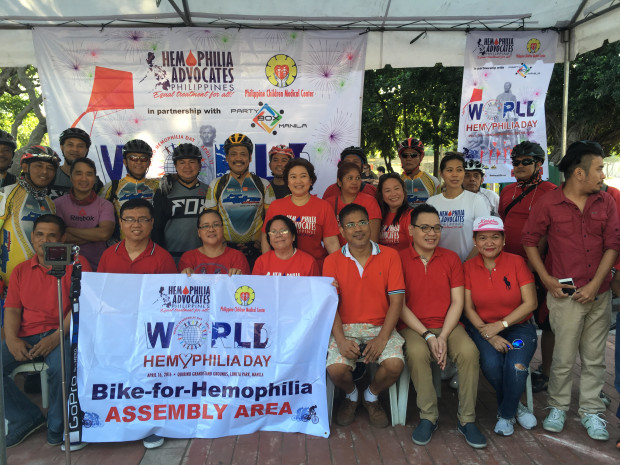Hemophilia patients seek gov’t attention

Participants in the celebration of World Hemophilia Day pose for a photo in Luneta, Manila, on Saturday. YUJI GONZALES/INQUIRER.net
In celebration of World Hemophilia Day, Filipinos with hemophilia and other rare blood diseases gathered on Saturday at Luneta in Manila to seek support from the government and raise public awareness on the disorder.
Andrea Trinidad-Echavez, cofounder of Hemophilia Advocates-Philippines who was diagnosed with von Willebrand Disease when she was already 36 years old, called on the government and presidential candidates in the upcoming May polls to take a look into their plight by reviewing the country’s public health system.
“‘Yung panawagan sana namin sa mga presidential candidates, kung sino man ‘yung manalo, i-review naman nila ‘yung public health system, kasi right now kagaya sa aming may rare and chronic diseases, napakamahal ng gamutan dito sa Pilipinas. Kami sa hemophilia, isang injection lang would cost a minimum P20,000 kung bata. Kung adult like me, minimum of P40,000. Kung hindi mag-stop ‘yung bleed mo, it can cost millions,” Echavez told INQUIRER.net in an interview.
“Kunwari ‘yung mga internal bleeds like brain bleeds and gastrointestinal bleeds, those are classified as life-threatening bleeds. Pwede talagang milyon ang gagastusin eh, kaya namamatayan kami ng mga pasyente kasi majority ay hindi kayang sagutin,” she said.
Hemophilia and other forms of bleeding ailments belong to a group of genetic disorders where the patient’s blood lacks the ability to clot normally, which can lead to severe bleeding episodes for minor injuries and spontaneous bleeding even without any cause.
Article continues after this advertisementAccording to the World Federation of Hemophilia, bleeding disorders affect one in every 1,000 or roughly 100,000 Filipinos, but only around 1,200 patients have been registered with the Philippine Hemophilia Foundation.
Article continues after this advertisementEchavez said patients were getting minimal support from the government in the form of a P2,000 PhilHealth coverage, but lamented that it was not even worth a single bag of blood.
“Kaya panawagan namin sana i-review, hindi lang naman para sa hemophilia, kasi yes meron tayong universal health act ‘di ba, pero tingin namin as patients medyo kulang pa rin ‘yun. Tapos alam naman natin ‘yung iba nating supposedly public servants they profess na mag-serve sa bansa, pero ‘yung iba alam natin napupunta lang naman sa bulsa ‘di ba. We’re not saying na corrupt silang lahat. We’re just saying na sa pagse-serve nila sa bansa, tignan naman nila ‘yung public health natin,” Echavez said.
“For now, merong minimal support because we get naman ‘yung PhilHealth coverage, but it’s P2,000 per incident. Eh kung kunwari ako, I would need 30 to 35 bags of blood for transfusion, I go to a private hospital, P5,700 per bag ‘yun. So ibig sabihin ‘yung coverage ko na P2,000 hindi nga nakakabili ng isang bag of blood eh. So ‘yun ‘yung mahirap sa part namin,” she added.
Echavez said the celebration of World Hemophilia Day was necessary to shed more light on the disease, especially because even doctors had misconceptions about it.
“It’s very important because it’s part of raising awareness about hemophilia and bleeding disorders, because even doctors, not a lot of them understand what hemophilia and bleeding disorders are. For example ako, I was diagnosed when I was already 36 years old. Bale nanganak ako, nagbi-bleed ako while I was pregnant. I gave birth prematurely to my three kids … There’s really lack of awareness even among doctors, that’s why it’s very important that we hold this event para magising din ‘yung general public, para maging aware sila about hemophilia,” she said.
Citing the need for a national health program for hemophilia, organization cofounder Ric Felipe, who was diagnosed with hemophilia when he was four years old, said treatment for hemophilic patients were being subsidized by the government in neighboring Southeast Asian countries like Malaysia, Thailand, and Vietnam.
“Right now, walang program ang government … although mayroon kaming napakaliit ng PhilHealth, I think that’s around P2,000 per episode. Considering na when we have bleeds, kung gagamit kami ng factor aid concentrate, which is one of the treatments nga—the most effective—kase kailangan effective at tsaka kahit papano less cost in the long run. So pag hindi kami nabigyan, makikita mo may mga deformities nga kami. So yun, awareness and education for the people who doesn’t still know about hemophilia,” he said.
But despite the odds, Villanueva remained optimistic that better things were yet to come as they had coordinated with the Department of Health and ahead of the national elections.
“Ngayon wino-work out ng DOH na masama kami sa Z-benefit package, wala pa siya pero in the works na siya. Z-benefit package is coverage ng PhilHealth for catastrophic diseases, meaning ‘yung mga diseases na medyo mahal, kagaya nitong hemophilia and bleeding disorders,” she said.
“It’s chronic eh, kasi hindi naman siya gumagaling. Nama-manage lang siya pero hindi talaga siya gumagaling kasi genetic disorder siya eh. Ang importante lang, at the onset of the bleed, mabigyan kaagad ng lunas para hindi lumala at hindi lumaki ‘yung gastos,” Echavez added.
The program started with a bike-for-hemophilia event, followed by a Mass officiated by running priest Fr. Robert Reyes, and a medical program officiated by doctors of the Philippine Children’s Medical Center. With reports from Aljon Tugaoen/RC